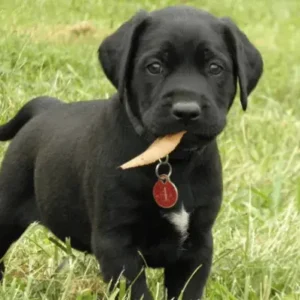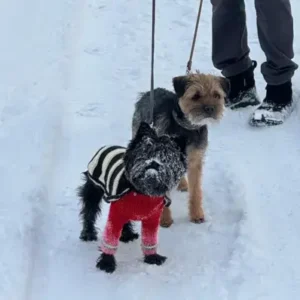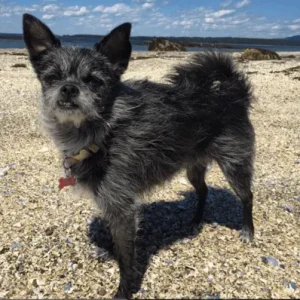Australian Shepherd Husky History/Origin
The Australian Shepherd Husky, often referred to as the Aussie Siberian or Australian Husky is a modern Australian Shepherd and Siberian Husky mix.
Australian Shepherd- Source: barcelona.aussie
Siberian Husky- Source: Pixabay
The Australian Shepherd originated in the Western United States in the 19th century, prized for its herding prowess and adaptability on ranches. Meanwhile, the Siberian Husky has ancient roots in Siberia, where it served as a sled dog for the Chukchi people.
The precise origins of the Australian Shepherd Husky are somewhat unclear. However, it likely emerged in response to the increasing popularity of designer breeds during the 1990s.
This mixed breed inherits a mix of traits from its parent breeds, including intelligence, agility, and endurance. This makes it well-suited for various roles, from working on the farm to being a beloved family pet.
Australian Shepherd Husky Personality
Australian Shepherd Huskies are one of the dog breeds known for their independent streak and resourceful nature, which can sometimes pose training challenges.
However, their intelligence and problem-solving skills make the effort worthwhile.
With a high energy level, they thrive on outdoor activities like walks, runs, or hikes, making them ideal companions for active individuals.
- Temperament
Despite their independence, they form deep bonds with their families and are incredibly loyal. They crave attention and affection, thriving on companionship and interaction with their humans.
These clever dogs enjoy mental stimulation and excel at learning new tasks. It’s essential to provide them with plenty of exercise and mental challenges to keep them happy and healthy.
Without enough activity, Aussie Siberians tend to get bored and resort to destructive behaviors. They also don’t do well being left alone for long periods. This is why they require consistent training from a young age to adjust.
With their affectionate nature, Australian Shepherd Huskies make wonderful companions for those willing to provide the attention and activity they crave.
- Variability
Understanding and accepting the variability inherent in mixed-breed dogs is crucial for potential owners. While breed characteristics can provide general guidelines, it’s essential to approach each dog as a unique individual with its own set of traits, needs, and preferences. Adopting or purchasing a mixed-breed dog requires flexibility. It also demands patience. Additionally, you need a willingness to embrace unpredictability and surprises. These qualities are essential when welcoming a new furry family member into your home.
Australian Shepherd Husky Physical Appearance
Their bodies are well-muscled and agile, reflecting their heritage as working dogs capable of enduring strenuous physical activity.
- Size
Australian Shepherd Huskies typically fall into the medium-sized dog category. They possess a sturdy and well-proportioned build, with males generally being slightly larger and more muscular than females.
- Coat Type and Colors
One of the most striking features of Australian Shepherd Huskies is their diverse coat colors. Their fur can come in a variety of shades, including black, white, brown, tan and cream. These colors often blend to create unique patterns and markings that make each dog visually distinctive.
Cream Australian Shepherd Husky- Source: kingbrenobento
Tan Australian Shepherd Husky – Source: kingbrenobento
Brown Australian Shepherd Husky – Source: kingbrenobento
Australian Shepherd Huskies boast a double coat that provides them with insulation against various weather conditions. The outer coat is medium-length and slightly coarse, offering protection from the elements, while the dense undercoat keeps them warm in colder climates.
Overall, they get their build and overall appearance from their parent breeds. Here’s a breakdown of the physical features it gets from its Australian Shepherd parent and Siberian husky parent:
| Physical Characteristic | Australian Shepherd | Siberian Husky | Australian Shepherd Husky |
| Size | Medium to large | Medium to large | Medium to large |
| Coat Color | Varied, often with striking patterns and markings | Varied, commonly black, gray, and white | Varied, often with striking patterns and markings |
| Coat Type | Double coat, medium-length, with a dense undercoat for insulation | Double coat, medium-length, with a soft, dense undercoat | Double coat, medium-length, with a dense undercoat for insulation |
| Eye Color | Varied, including brown, blue, or amber | Blue, brown, or heterochromatic | Varied, including brown, blue, or amber |
| Ear Shape | Triangular, erect | Triangular, erect | Triangular, erect |
| Tail | Naturally bobbed or docked, sometimes long and feathered | Bushy, often curled over the back | Variable may be naturally bobbed, docked, or long and feathered |
| Body Build | Sturdy and well-proportioned, muscular | Athletic and graceful, built for endurance | Sturdy and well-proportioned, muscular |
| Facial Expression | Alert and intelligent | Friendly and expressive | Alert and intelligent |
Australian Shepherd Husky Gender Differences
In terms of temperament and physical characteristics, male and female Australian Shepherd Huskies typically have little to no differences. However, individual personalities may vary.
Australian Shepherd Husky Feed/Nutrition
Ensuring optimal nutrition is paramount for the health and vitality of Australian Shepherd Huskies. A diet rich in high-quality protein and essential nutrients is crucial to support their active lifestyle and maintain overall well-being.
Look for dog foods that prioritize meat or meat meals as primary ingredients to provide the necessary protein for muscle development.
Additionally, a balanced diet including carbohydrates, fats, vitamins, and minerals is essential to meet their nutritional needs. Consider supplementing their diet with omega–3 fatty acids, found in sources like fish oil and shrimp, to promote healthy skin and coat.
Portion control is vital for preventing obesity in Australian Shepherd Huskies. Monitor their food intake carefully and consult your vet for appropriate feeding guidelines based on age, weight, and activity level.
Lastly, always ensure access to fresh water and consult with your vet to tailor a feeding regimen that suits your Australian Shepherd Husky’s requirements.
Australian Shepherd Husky Health
While generally healthy, Australian Shepherd Huskies may be prone to certain inherited health conditions common to their parent breeds, including:
- Elbow Dysplasia: Elbow dysplasia is a common orthopedic issue in Australian Shepherd Huskies, leading to joint discomfort and lameness. Veterinary care, including diagnostic imaging and potential surgical intervention, is crucial for managing this condition effectively and improving the dog’s quality of life.
- Cataracts: Cataracts, prevalent in Australian Shepherd Huskies, result in the clouding of the eye’s lens, potentially leading to vision impairment or blindness. Regular eye examinations by a veterinary ophthalmologist are necessary to monitor cataract progression, with surgical options available to restore vision and enhance the dog’s well-being.
- Hip Dysplasia: Hip dysplasia, a prevalent concern in Australian Shepherd Huskies, involves abnormal hip joint development, causing pain and mobility issues. Management strategies include weight management, physical therapy, anti-inflammatory medications, and in severe cases, surgical intervention to improve joint function and alleviate discomfort.
- Epilepsy: Epilepsy, characterized by recurrent seizures, can affect Australian Shepherd Huskies, impacting their quality of life. Treatment typically involves antiepileptic medications to control seizures.
Prospective owners need to understand that health issues can arise in any breed. However, responsible breeding practices can help mitigate these risks. Proactive healthcare is also essential. These measures can ensure the well-being of Australian Shepherd Husky mixes throughout their lives. Regular veterinary check-ups, a nutritious diet, and plenty of exercise are essential for maintaining their health and happiness.
Australian Shepherd Husky Care and Grooming
Australian Shepherd Huskies require regular care and grooming to keep them healthy and looking their best.
Brushing your Australian Shepherd Husky’s coat several times a week is essential to remove loose fur, dirt, and debris.
Australian Shepherd Husky Grooming – Source: brookes_doggrooming
Use a slicker brush or undercoat rake to penetrate the dense double coat and prevent mats and tangles from forming. Pay special attention to areas prone to matting, such as behind the ears, under the legs, and around the tail.
Bathe them when necessary with gentle dog shampoo, rinsing well to avoid skin irritation. Trim their nails regularly to prevent discomfort and avoid nail problems.
Check their ears for wax buildup and clean them gently with a damp cotton ball. Also, brush their teeth often with dog toothpaste and provide dental chews to keep their mouth healthy.
If you’re unsure about any grooming task, it’s always a good idea to ask a professional groomer or vet for help. Additionally, house training your dog is essential to ensure they develop good habits and have a comfortable living environment.
Australian Shepherd Husky Rescue Groups
Finding a rescue dog of this mixed breed could be hard, however, you can find multiple rescue homes that specialize in Australian Shepherd and Husky mixes.
Australian Shepherd Husky Price
The price of an Australian Shepherd Husky mix usually ranges from $500 to $1,500, depending on the breeder and the dog’s characteristics.
When searching for Australian Shepherd Husky mixes available for adoption, it’s essential to research and identify reputable rescue organizations. Look for organizations that prioritize the well-being of their dogs, provide comprehensive veterinary care, and conduct thorough screening processes for potential adopters.
Interesting Facts
- The Australian Shepherd Husky cross has multiple names that it goes by. Some of the common ones include Aussie Siberian, Aussie Husky and Australian Husky Sheppie.
- While this crossbreed is not recognized by the American Kennel Club, the Australian Shepherd Husky Mix is recognized by The Dog Registry of America and The International Designer Canine Registry.
Best For
Australian Shepherd Huskies are best suited for active individuals or families with plenty of time and energy to devote to their care and exercise needs.
Australian Shepherd Husky Top Names
| Male Australian Shepherd Husky Names | Female Australian Shepherd Husky Names |
| Titan | Luna |
| Blaze | Willow |
| Diesel | Nova |
| Jasper | Dakota |
| Odin | Ember |









 Australian Shepherd- Source:
Australian Shepherd- Source:  Siberian Husky- Source:
Siberian Husky- Source: 

 Cream Australian Shepherd Husky- Source:
Cream Australian Shepherd Husky- Source:  Tan Australian Shepherd Husky – Source:
Tan Australian Shepherd Husky – Source:  Brown Australian Shepherd Husky – Source:
Brown Australian Shepherd Husky – Source:  Australian Shepherd- Source:
Australian Shepherd- Source:  Siberian Husky – Source:
Siberian Husky – Source:  Australian Shepherd Husky- Source:
Australian Shepherd Husky- Source:  Australian Shepherd Husky Grooming – Source:
Australian Shepherd Husky Grooming – Source: 







